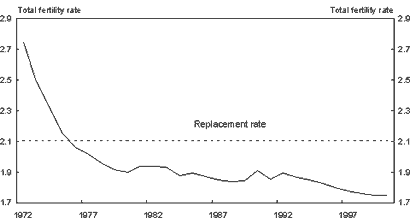The release of the first Intergenerational Report as part of the 2002-03 Budget has started a very valuable debate on the demographic changes to our society and the effect that these will have on future Government expenditures.
The "ageing" of the population is a term used to describe the rising proportion of people of retirement age compared to people of working age. People of working age are commonly considered to be those aged between 15 and 65 years. People of retirement age are those aged 65 years and above. People of working age are the primary income tax payers in our society. People of retirement age pay much less income tax because they have retired from the workforce.
At the moment there are 5.4 people in the working age population for each person of retirement age. By 2020 that number is estimated to decline to 3.7 and by 2040 it is estimated to decline to 2.5.
Advertisement
Australia is expected to have a relatively constant number of people of working age over the next forty years, but the number of those at retirement age will grow by about 3.8 million. The proportion of those in retirement to those in the workforce is growing.
Interestingly enough, the Intergenerational Report identifies another huge cost pressure that will grow over the next forty years in addition to the ageing of the population. This is the cost arising from health spending, particularly on the Pharmaceutical Benefits Scheme, which is driven by the development of new technology and treatments. Whilst it is true that older people draw-down much more heavily on medical services and pharmaceutical benefits, even without the ageing of the population, the draw-down on pharmaceutical benefits would increase quite substantially. This is the result of scientific discoveries. These produce new treatments by the day, at high cost, which have to be subsidised by taxpayers if they are to be available to all those wanting treatment.
Why is the population "ageing" in this proportionate sense? Two factors are at work here. The first is that people are living longer because of improvements in standards of living and medical care. The other is that birth rates are declining. A lot of interest has focussed on the declining birth rate recently.
The Intergenerational Report shows the fertility rate in Australia over the last 30 years.

Chart 1: Australia’s historical total fertility rate
Advertisement
The total fertility rate represents the number of children a woman would bear during her lifetime if she experienced the current age-specific fertility rates at each age of her reproductive life. Age-specific fertility rates are equal to the average number of children born to a woman of a particular age in one year.
One response to this decline in the fertility rate has been the suggestion that the Government should fund a system of universal maternity leave.
There are arguments for and against a system of universal maternity leave. It is not the purpose of this article to consider those. The purpose of this article is to suggest that paid maternity leave is not a fertility policy.
Discuss in our Forums
See what other readers are saying about this article!
Click here to read & post comments.
1 post so far.